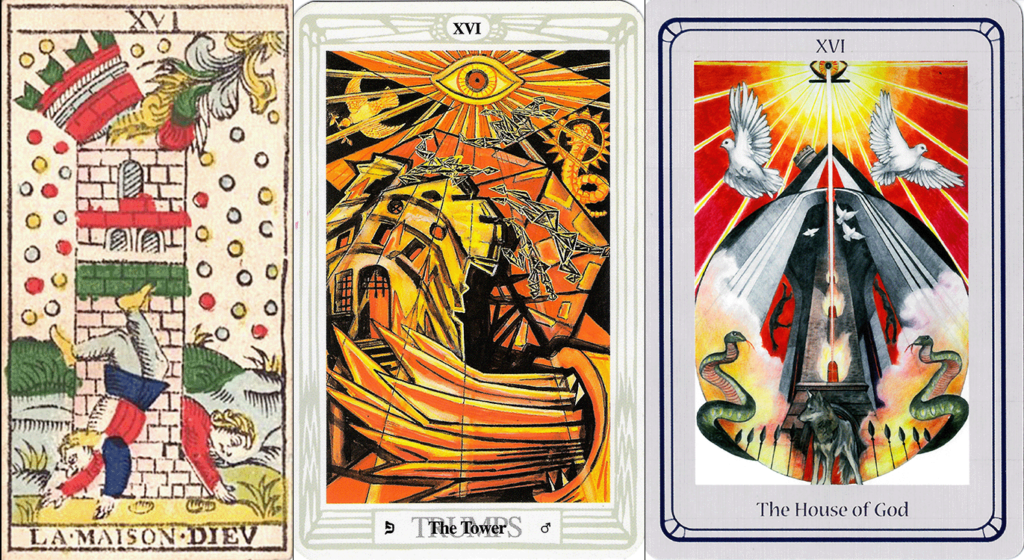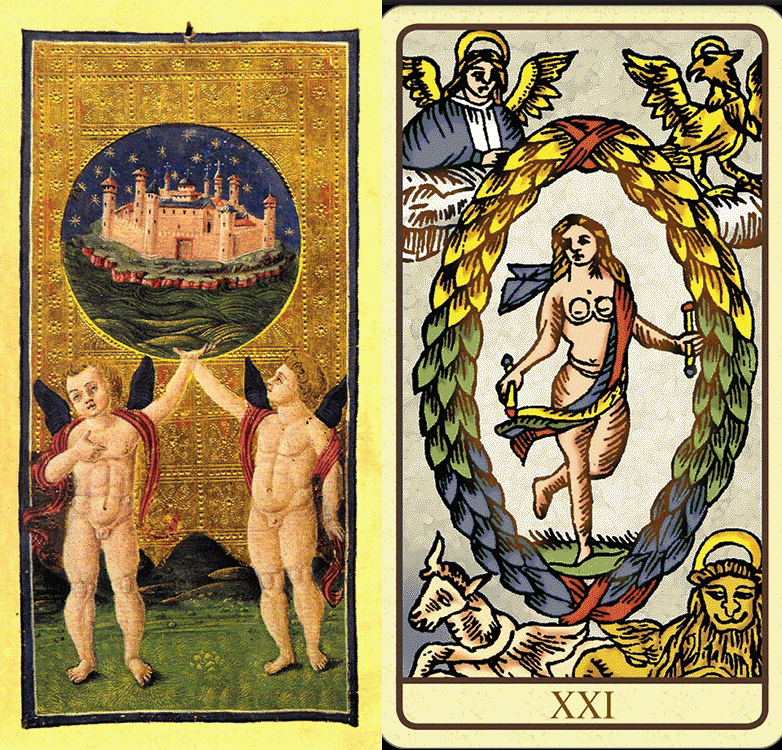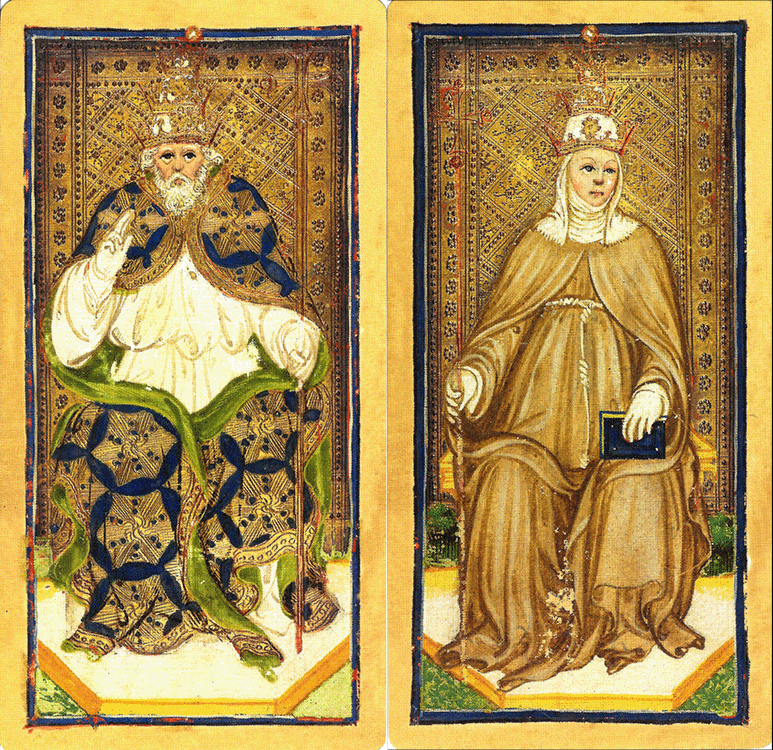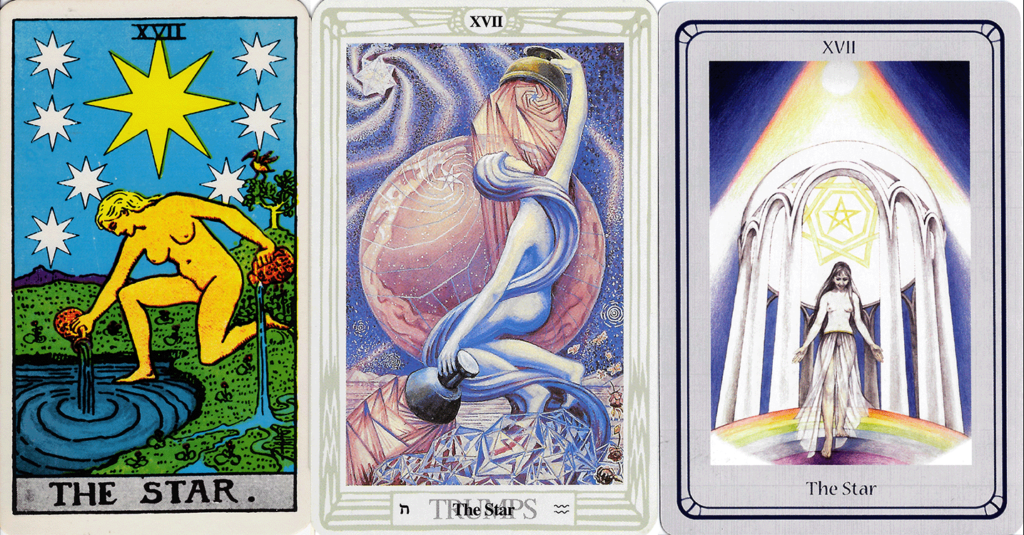For God’s sake let us sit upon the ground
Richard II – Act 3, Scene 2 – William Shakespeare
And tell sad stories of the death of kings:
How some have been depos’d, some slain in war,
Some haunted by the ghosts they have deposed,
Some poisoned by their wives, some sleeping kill’d,
All murthered—for within the hollow crown
That rounds the mortal temples of a king
Keeps Death his court, and there the antic sits,
Scoffing his state and grinning at his pomp,
Allowing him a breath, a little scene,
To monarchize, be fear’d, and kill with looks;
Infusing him with self and vain conceit
As if this flesh which walls about our life
Were brass impregnable; and, humour’d thus
Comes at the last, and with a little pin
Bores thorough his castle wall, and farewell king!
Card XIII is one of the most dreaded cards to see in any reading. It is simply called Death, and carries with it all the foreboding baggage we attach to that word in our communal culture. Death is without doubt one of the most feared parts of the human experience. It is an inexplicable enigma that haunts our steps from the day we enter into the world. Yet it’s place in Tarot is very much open to discussion.
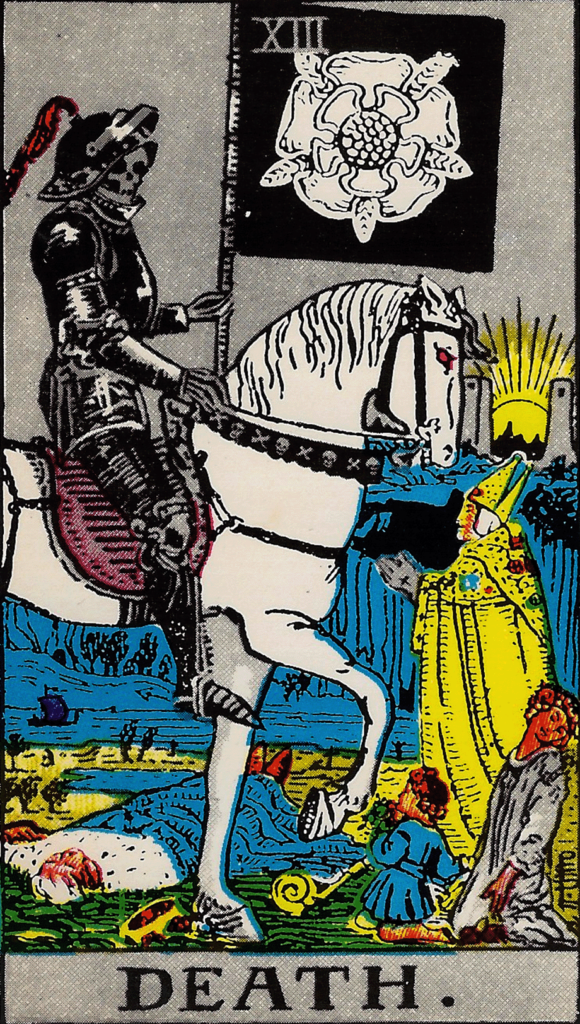
The Rider-Waite-Smith version departs from previous imagery of the Reaper mowing down humans indiscriminately. Instead, Pamela Colman Smith chooses to show the figure of Death as the Black Knight, mounted on horseback, with his black banner dominant over all. The banner is marked by a five-lobed white Tudor rose. That this may be seen as an inverted pentagram is not without intention. His horse is white, its red eyes mark it as an albino. The bridle barding is a sequence of skulls and crossed bones. The horse and rider are taken from the Apocalypse of St. John, in the book of Revelations. “ And I looked, and behold a pale horse: and his name that sat on him was Death, and Hell followed with him.” This figure of Death on horseback is something we begin to find in the Renaissance, particularly in the work of Northern painters like Albrecht Durer. He is perhaps not so nobly depicted as he is on the 14th trump card, but the figure clearly is the Pale Rider. Much of the rest of the tableau depicted here comes from older memento mori imagery. Before the horse stands a bishop or other prelate, praying for Death to spare him. On her knees next to him is a swooning woman, and a child. They are both crowned with roses, and the child holds a bouquet of these flowers. Just in front of the child is the bishop’s crozier. The front right hoof of the horse is poised above it, ready to stamp down and smash it. Underneath the horse is the body of a king, his crown upside down in the dirt behind the horse’s other foreleg. In the background is a landscape, at the rear of which is a river. A single boat is in the middle of the river. Behind the bishop we see the suggestion of a waterfall, and above the waterfall the river leads toward two towers, with the sun setting between them. The sky is a uniform gray, and the part of the landscape from the river’s edge backward, is covered in the shadow of evening, as the light is dying.
This card is positively ripe with symbolism, probably because we have been working with visual metaphors for death since our earliest human consciousness. Death, as a thing, is both easily expressed and yet completely unexplainable. It is a cessation of a number of biological processes that we use to determine if something is “alive”. Although when we get down to the level of something like a virus, these processes are much simpler, for human beings we think of things like breathing, having a heartbeat, walking, talking, eating, excreting, making babies and similar things that we all have in common. When we stop doing that, we are considered dead. The body ceases to operate. The meat suit is no longer inhabited by us, and begins a number of other biological processes which are the result of other life now regarding the meat suit as just meat.
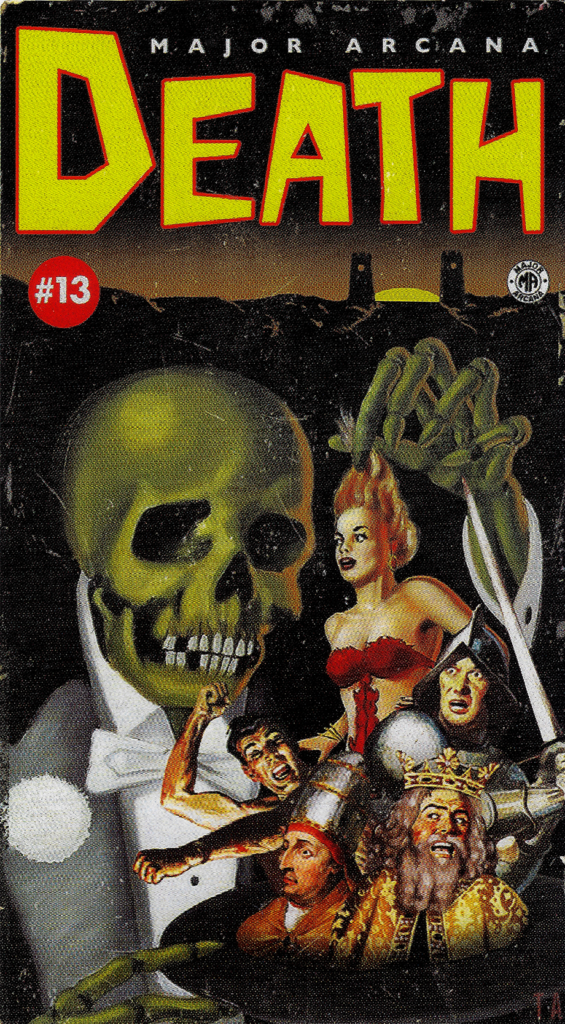
The thing that makes Death such a mystery is that it is inherently and almost always a permanent state. It is, in fact, the only permanent state that human beings experience. Everything else about us is changeable. We grow, we age, we move, we hunger, we sleep, we reproduce. Nothing is ever exactly the same way twice. But when all that stops, well, it stops forever. So in our modern culture we tend to consider that forever as Death, when really what we mean is loosely termed the “afterlife”.
Afterlife as an idea has been around a long time. It’s hard to say whether our near neighbors the chimps and bonobos have some concept of loss when a member of their community stops functioning. In my personal experience, though, I believe that animals do experience a sense of death, and of loss, both for other animals and for their humans. My grandfather’s dog died the day he did, even though my grandfather died in a hospital several hundred miles away. We found the little dog, who had been healthy and really should have lived for several more years, quietly passed in his pen. I have heard numerous such stories from friends and family.
But as humans, we seem to have become aware of something significant occurring as far back as the Neanderthal times. It is in this culture that we start to see what archaeologists call “grave goods”. That is, there are things buried along with the bodies of the people. Let’s examine what that may tell us about those early humans.
The reason to bury the dead is actually fairly basic. It’s sanitary, and keeps the decomposition from attracting big scavenger/predators to the rest of the tribe. But when it comes to a reason for burying things with the dead person, it becomes a bit more complicated.
Firstly , it may simply be that those things belonging to the dead might have been related to the death. That is, there was some fear of contagion. This potentially grew from folklore passed down when someone did get sick and die when they kept poor old Ugg’s mammoth hide cape. Now to a culture that doesn’t have sophisticated bacteriology, this idea of quarantine is as much about spiritual causes as it is about the bug. True, it may have been a nasty bacillus that brought down Ugg and sadly young Groont picked it up from the fleas in that mammoth hide. But to the people of the tribe, this was the work of an evil spirit, or an angry god, or something like that, because they didn’t have any idea about the bacillus. Hence for the future, all mammoth hides would be buried with their owners when the time came.
Secondarily, such a culture might determine that it was Ugg himself that had caused the harm to Groont, because he had really liked that mammoth hide, and he didn’t feel like Groont was going to take proper care of it. This idea that the spirit of the dead, once out of the meat suit, could still affect the affairs of the living folks, is something that evolves throughout our history. There is some point in time where the giving of grave goods served the dual purpose of appeasing the spirits of the dead, and providing them with access to their stuff once they’d shuffled off the ol’ mortal coil. If there was no more Ugg, why would he care if Groont got his cape or not. But, if Ugg was still hanging around, even though the Ugg meat suit was taking the long dirt nap, it might be very important to keep him pleased. Who knows what sort of mischief an irritated invisible Ugg could get up to? And, well, how do you get rid of him if you can’t kill him?

So offerings get made, stuff gets buried, and the dead become the Venerated Ancestors because somewhere in our early caveman days we began to conceive of this concept of afterlife. Afterlife is heaven and hell and ghosts and zombies and vampires and the numerous other incarnations of the unquiet dead. It’s also reincarnation and karma and past lives and the search for Nirvana.
But it’s not Death. Death is a moment. Death is the moment where the meat suit goes from being us to being meat.
And as with many moments that exact point is still sort of nebulous and mysterious. And scary. As people progressing through our living years, we all create or internalize some sort of belief about afterlife that gives us a shield against the inevitability of Death itself. But no matter how assured we are of inhabiting the spiritual Disneyworld promised by many religions and beliefs, that actual moment of Death still shakes us down to our very cores.
So when that card marches out in a reading, you still hear the sudden intake of breath. The pupils dilate. Sweat forms on the upper lip. No, surely, it is not my time. No!
Oh, no. It’s just symbolic. A sign of transition. Of changing from one state to another. That’s the usual response. Please don’t panic, Death isn’t really Death.
Except, of course, when it is.
The origin of the images on this card is the Middle Ages, and the Black Death. The Grim Reaper, who is more plainly drawn on the Tarot de Marseilles, is another emblem of this terrifying time in European history, when at least one quarter of the local humanity died. The great Bubonic Plague coincided with widespread belief that the time of Christ’s return was at hand, as it had been about a thousand years since the Crucifixion and the Resurrection. As an invisible Angel of Death swept whole villages from the earth, it was very easy to believe that the end times had come.
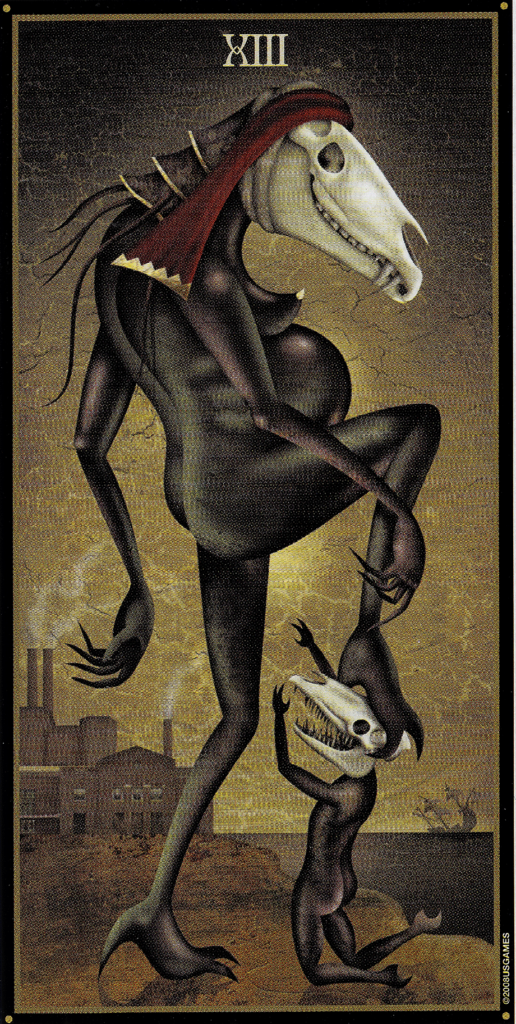
Ironically the mass extinction event changed the economic structure of Europe. Feudalism, based on a large population of people to work the land, was no longer sustainable. Labor and skills were in short supply, and in basic economic fashion, when supply is less than demand, the price goes up. People were able to rise in personal property and social status, by contracting themselves to the highest bidder. This brought about the flowering of art and culture we call the Renaissance.
So in it’s way, even the big bad Black Death on that XIII card was a transitionary force. The old society died with it, but the new one grew from the ashes.
The plague killed without distinction. Young, old, rich, poor, noble, slave, pious, and sinful. The figures surrounding the Black Rider represent this idea that Death was the great equalizer. No amount of money, or power, or faith, could protect you.
The catchphrase of the time was “Memento mori” – “Remember you will die”.
While this may have begun as church propaganda to convert the heathen, it could certainly have been a bumper sticker on the daily death wains that roamed many Medieval towns and cities calling for people to bring out their dead.
The injunction, of course, was aimed at cajoling the populace into proper Christian behavior, since, at any moment, they too, could make that final journey. In the climate of the day, real fear was attached to dying with sin on your heart, unable to make final confession and atonement, before facing the final judgement.
But consider this message in a different light.
Let’s say you’ve been told you have a fatal incurable disease and your have that proverbial six months to live. Assuming this illness doesn’t impair your abilities terribly, and is not contagious, what choice would you make to do with that six months?
Some people, sadly, would spend the entire time in fear, depression, and anger, bemoaning whatever mad fate put upon them this horrible doom. They would be miserable, and they would make everyone around them miserable, and when they were gone, their loved ones would carry that misery around forever as their last memory of the person.
Some people will pull out that bucket list, crack open the bank accounts, and live life to the fullest seeing and doing all those things they dreamed about until the very end when the dark comes upon them. That leaves behind a better legacy with their families and friends, unless, of course, they were hoping to inherit what got spent on that last blast of gusto.
But there is the third option, to do something that lasts. Maybe they make a painting, or write a novel, or go spend six months feeding the poor in the some wretched forgotten corner of the earth. But they give up that last measure of their days to leave something behind, so that when the meat suit is fully consumed, and the material nature of the life they lived is gone, something remains in the world that is a mark of their having been in it.

The Renaissance, for all the secular humanism and often hedonism, is this bright shining of life and light as compared to the long dark fear of Death that marked the world of the Middle Ages. In many ways, our modern world still has not fully come to terms with that phobia that rose from the Plague Years. Nor do we always live up to that promise of using the time we are given to best effect.
The sun is always setting somewhere. And always rising somewhere. While the funeral ship is sailing into the lands of shadow, there is another ship setting off to meet the dawn.
Our entire existence is a world that is dying or dead. The majority of the stars we see above burned out a long time before our earth even spun in space. It is the merest memory of their life that makes up our reality. It is fair to say that we are constantly in that moment of Death, moving from the things that were to the things that will be. The past lies lost behind us, and the future is never quite reached. The now is what we have, and we better make use of it.
The Death card is not simply a marker of transition or change. It is the proof of the inevitability of change. Nothing that is, remains. It is a goad to get up and go out and live while we can, to not wait for the moment when we are asked to hop up on that horse, and only then beg and lament our wasted days.
I do not fear Death. Even the pain that may accompany it, if that be my fate, is transitory. It ends. Death is over quickly, and what is beyond Death, I cannot say. What is on this side of Death though, lies within my willingness to act. And act I will.
I hope this has helped you understand a little more about this complicated and often dreaded card. Next week we shall explore Temperance, which is not only a rather odd card to work through, but also sits in a strange place in the sequence of trumps. I hope you will join me again.
As a footnote, I would like to thank all those brave souls who asked me to read the cards for them at the Writers for New Orleans event this past weekend. I know there were some that time did not permit me to visit with, and I hope we will have a future opportunity to explore the Tarot together.
I’ll be back next week.




